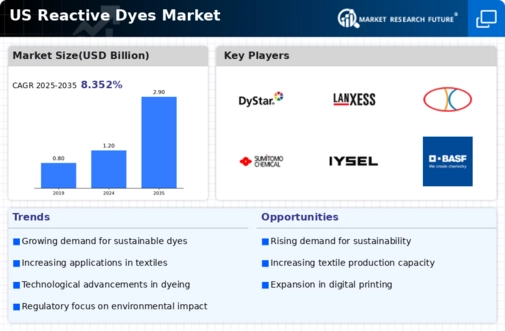The US Reactive Dyes Market is characterized by a dynamic landscape marked by various manufacturers and suppliers competing for a significant share. The market is driven by the increasing demand for textile products and synthetic fibers, with reactive dyes being a preferred choice due to their excellent color fastness and versatility.
Companies in this sector continually innovate and enhance their product offerings, focusing on sustainability and eco-friendly solutions. The competitive environment is shaped by technological advancements, consumer preferences for higher quality products, and regulatory standards that govern dye manufacturing and applications.
As a result, companies are adopting different strategies, such as mergers and acquisitions, partnerships, and expanding their product lines to maintain a competitive edge. Dystar plays a prominent role in the US Reactive Dyes Market, known for its strong presence and extensive range of products. The company has established itself as a leader in providing robust solutions for the textile industry, leveraging its experience and expertise to deliver high-quality dyes and tailored services.
Dystar’s strengths lie in its commitment to sustainability and innovation, offering dyes that meet stringent environmental standards, which resonates well with increasing consumer demand for eco-friendly products. Their continuous investment in research and development allows them to stay ahead of market trends, ensuring that they can offer cutting-edge products that enhance color vibrancy and durability.
The company's strong distribution network across the US enables it to reach a diverse customer base effectively, further solidifying its position in the market. Savita Chemicals is another significant player within the US Reactive Dyes Market, focusing on providing a wide range of dye products that cater to the needs of various industries.
The company is recognized for its robust manufacturing capabilities and commitment to quality, offering products such as reactive, direct, and acid dyes to meet the specific requirements of its clientele. Savita Chemicals has made notable strides in establishing a strong market presence through strategic partnerships and alliances, ensuring they have the reach to supply an extensive customer base across the US.
The company's strengths include its innovative approach to product development, which emphasizes sustainability and compliance with industry regulations. Additionally, Savita Chemicals has engaged in mergers and acquisitions to enhance its market position and product portfolio, creating a comprehensive range of solutions for its customers in the dye manufacturing sector.




















Leave a Comment